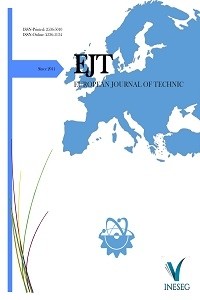PRODUCTION OF CURVED SURFACE COMPOSITES REINFORCED WITH RUBBER LAYER
PRODUCTION OF CURVED SURFACE COMPOSITES REINFORCED WITH RUBBER LAYER
Glass fiber, EPDM Rubber, Vacum infusion Curing, Delamination,
___
- Referans1 Valença, S.L., Griza, S., de Oliveira, V.G., Sussuchi, E. M., de Cunha, F.G.C. (2015). Evaluation of the mechanical behavior of epoxy composite reinforced with Kevlar plain fabric and glass/Kevlar hybrid fabric. Composites Part B: Engineering, 70, 1-8.
- Referans2 Sangemesh, Ravishankar, K.S., Kulkarni, S.M. (2018). Ballistic Impact Study on Jute-Epoxy and Natural Rubber Sandwich Composites. Materials Today: Proceedings, 5(2), 6916-6923.
- Referans3 Vishwas, M., Joladarashi, S., Kulkarni, S.M. (2017). Behaviour of natural rubber in comparison with structural steel, aluminium and glass epoxy composite under low velocity impact loading. Materials Today: Proceedings, 4(10), 10721-10728.
- Referans4 Adachi, T., Ozawa, T., Witono, H., Onishi, S., Ishii, Y. (2017). Energy absorption of thin-walled cylinders filled with silicone rubber subjected to low-velocity impact. Mechanical Engineering Journal, 4(5), 17-00052.
- Referans5 Sabah, S.A., Kueh, A.B.H., Al-Fasih, M.Y. (2018). Bio-inspired vs. conventional sandwich beams: A low-velocity repeated impact behavior exploration. Construction and Building Materials, 169,193-204.
- Referans6 Khodadadi, A., Liaghat, G., Bahramian, A. R., Ahmadi, H., Anani, Y., Asemani, S., Razmkhah, O. 2019. High velocity impact behavior of Kevlar/rubber and Kevlar/epoxy composites: A comparative study, Composite Structures, 216, 159-167.
- Referans7 Park, H., Jung, H., Yu, J., Park, M., Kim, S. Y. 2015. Carbon fiber-reinforced plastics based on epoxy resin toughened with core shell rubber impact modifiers. e-Polymers, 15(6), 369-375.
- Referans8 Li, W., Li, R., Li, C., Chen, Z. R., Zhang, L. 2017. Mechanical properties of surface‐modified ultra‐high molecular weight polyethylene fiber reinforced natural rubber composites. Polymer Composites, 38(6), 1215-1220.
- Referans9 Haworth, B., Chadwick, D., Chen, L., Ang, Y. J. 2018. Thermoplastic composite beam structures from mixtures of recycled HDPE and rubber crumb for acoustic energy absorption. Journal of Thermoplastic Composite Materials, 31(1), 119-142.
- Referans10 Sivaraman, R., Roseenid, T. A., Siddanth, S. 2013. Reinforcement of elastomeric rubber using carbon fiber laminates. International Journal of Innovative Research in Science, Engineering and Technology, 2(7), 3123-3130.
- Referans11 Erdem, S., Nonlinear buckling analysis in patched hybrid composite plates by vacuum infusion method, Ph. D. thesis, Fırat University, Elazığ, Turkey, 2020.
- Referans12 Stelldinger, Enrico, Arnold Kühhorn, Markus Kober. 2016. Experimental evaluation of the low-velocity impact damage resistance of CFRP tubes with integrated rubber layer. Composite Structures,139, 30-35.
- Referans13 Taherzadeh-Fard, A., Liaghat, G., Ahmadi, H., Razmkhah, O., Charandabi, S. C., Zarezadeh-mehrizi, M. A., Khodadadi, A. 2020. Experimental and numerical investigation of the impact response of elastomer layered fiber metal laminates (EFMLs). Composite Structures, 112264.
- ISSN: 2536-5010
- Yayın Aralığı: Yılda 2 Sayı
- Başlangıç: 2011
- Yayıncı: Hibetullah KILIÇ
MODELING AND ANALYSIS OF PITCH ANGLE CONTROL ON VARIABLE SPEED WIND TURBINES
Hasan Bektaş PERÇİN, Abuzer ÇALIŞKAN
MODELING THE CA2+CAMKII NETWORK OF LTP IN THE JIGCELL ENVIRONMENT
CLASSIFICATION OF ANALYZABLE METAPHASE IMAGES BY EXTREME LEARNING MACHINES
DE-ORBITING ELECTRO-MECHANICAL SYSTEM DESIGN FOR MICRO SPACECRAFT
DESIGNING A CONTROL INTERFACE AND PID CONTROLLER OF CUK CONVERTER
EXPERIMENTAL INVESTIGATION OF THE MECHANICAL AND MICROSTRUCTURE PROPERTIES OF S49 RAIL STEEL
Anıl RIDVANOĞULLARI, Tayfun ÇETİN, Mehmet AKKAŞ
Çağlar AYDIN, Sencer ÜNAL, Mehmet ÖZDEMİR
ENRICHMENT OF APATITE-BEARING IRON ORE BY MAGNETIC SEPARATION AND FLOTATION
